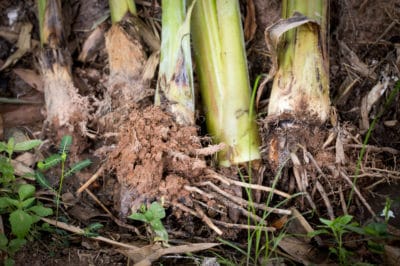Anatomy of the Banana Plant
Like a tulip or other flowering bulb, most of what you see when you look at a banana is leaves. The so-called trunk of the banana tree is actually a tightly packed roll of leaves. The leaves emerge from the center of the “trunk.” This structure – known as the pseudostem – derives its strength from the overlapping curvature of the leaf stems.
Banana Relatives
If you compare bananas to their relatives ginger and bird of paradise flower, you’ll quickly see similarities. Each has a knobby underground rhizome from which leaves spring. Ginger rhizomes branch from the main root, each producing leaves. The bird of paradise flower develops thick, twisted rhizomes in similar fashion to what is called the root mat of a banana.
Climates for Bananas
Commercial edible bananas are tropical fruits, although some varieties can be grown outdoors in the US in USDA Zones 10 and 11. Plantains, or cooking bananas, have a slightly wider range and are grown in much of the American south. Ornamental bananas are often grown indoors or in containers, but primarily as foliage plants.
How to Grow Bananas
The banana is a heavy feeder, especially during the period when it is throwing up leaves and developing a flower stalk. It needs:
- Full sun or morning sun and dappled afternoon shade.
- Plenty of water but very well-draining soil.
- Enriched soil – especially in containers.
- Regular applications of fertilizer during the growing period.
Reproducing Bananas
Although non-edible banana varieties can be grown from seed, most growers prefer vegetative propagation. The plant throws up suckers from its main bulb, or rhizome, which can be divided from the mother plant and replanted in pots or the ground. You can also replant the main bulb in new potting soil, although suckers typically grow better.
Propagating New Plants
The root mass, or mat, of a banana plant includes the bulb/rhizome, suckers and roots themselves. In the mature plant, this mat can grow five feet deep and spread over 30 feet. Suckers can be narrow-leaved (sword suckers) or broad-leaved (water suckers). The former are a better choice for propagating new plants.
Storing Banana Bulbs
If you live in a cooler climate, you can dig and store the bulb in a dark space where the temperature does not drop below freezing. Cut off lower leaves and pry the bulb out of the soil. Cut off roots that extend out of the sol mass – they’ll rot. Place a plastic garbage bag over the root mass and move to storage. Do not water unless roots seem very dry and wilted.
